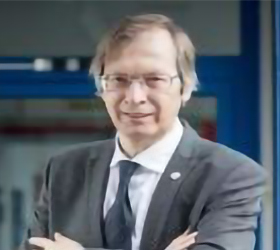
Dejan Milosevic
Chairman of the Council for Science and Arts
University of Sarajevo
Bosnia and Herzegovina
Editor
Born July 5th, 1959, in Sarajevo, Bosnia and Herzegovina. Primary School and Gymnasium in Sarajevo. Graduated (Gold medal award) in 1981 at the Faculty of Science, University of Sarajevo (UNSA). Postgraduate study of theoretical physics at the Faculty of Physics, Faculty of Science and Mathematics, University of Belgrade: MSc thesis 1986, PhD thesis Atomic processes in a strong laser field 1990. 1982-1984 assistant at the Institute of Physics, Faculty of Science, UNSA. From 1984 to 1998 researcher in optical company “Zrak”, Sarajevo. Since 1991 assistant professor for the subject Lasers and infrared technique at the Faculty of Mechanical Engineering, UNSA. Professor of theoretical physics at the Faculty of Science, UNSA (associate professor 1998 and since 2004 full professor). Postdoctoral research visits: Belgium (8 months, 1995), Austria (3x2 months, 1997-1998), USA (1 year, 1998), Max-Born-Institut für Nichtlineare Optik und Kurzzeit-Spektroskopie, Berlin, Germany (Alexander von Humboldt Fellowship, 14 months, 1999-2000). Member of the Academy of Sciences and Arts of Bosnia and Herzegovina (corresponding 2008 and since 2012 full member). Since 2014 member of the European Academy of Sciences and Arts. UNSA Award for the best professor in 2008/2009. The individual Sixth of April Award of the City of Sarajevo in 2011. Plaquette award for remarkable achievements in scientific research, Faculty of Science, UNSA, 2016. Outstanding Reviewer Awards 2017 (Reviewer of the year for Journal of Physics B). The Sarajevo Canton Plaquette in 2018. Bosnia and Herzegovina State Award in the Field of Science for International Success in 2017. Georg Forster Research Award by the Alexander von Humboldt Foundation in 2018. According to Web of Science Milosevic DB has above 190 papers cited above 7700 times (h-index 46).
My research is mostly concerned with atomic and molecular processes in strong external laser fields. Together with my collaborators I have shown that the Feynman path integral method and quantum orbits are a natural framework for the analysis of these processes (Science 292, 902 (2001)). Using this formalism, I have successfully simulated a large number of experiments and explained the physics of various strong-field phenomena. The development of strong-laser-field physics and attoscience has become possible after the discovery of new laser sources. A half of the Nobel prize in physics in 2018 was awarded to Gerard Mourou and Donna Strickland for their method of generating high intensity ultrashort pulses. I was lucky that they developed this method in 1985, just at the time when I was starting my scientific career, so that I can consider myself to be a pioneer of this area of science. My most recent accomplishments are based on my earlier development of the quantum-orbit theory of atomic processes in a so-called bicircular field (2000). It has recently been confirmed experimentally that with this field it is possible to generate attosecond pulses of circularly polarized soft x-rays, which have important applications (Proc. Natl. Acad. Sci. USA 112, 14206 (2015)). In my latest achievement (2016), I have proposed that using such a field it is possible to consider effects of electron spin on the attosecond time scale.